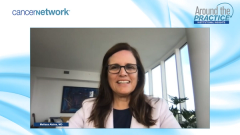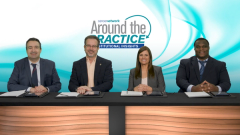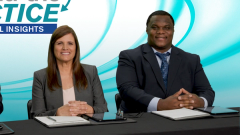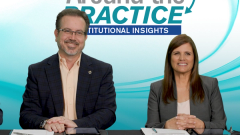
BCMA-Targeted Therapies in Relapsed/Refractory Multiple Myeloma
Following their discussion on teclistamab, experts from the Moffit Cancer Center highlight other BCMA-targeted therapies available in the relapsed/refractory setting of multiple myeloma.
Episodes in this series

Transcript:
Melissa Alsina, MD: [In addition to] teclistamab, there are other bispecifics in clinical trials. At ASH [the American Society of Hematology Annual Meeting] they presented the data on belantamab [mafodotin]. Do you want to comment on that? How does it look, and what are the targets of that particular drug?
Ken Shain, MD: There are a number of ongoing trials and hopeful agents that are bispecific antibodies targeting BCMA. That’s the same target as teclistamab, which is the first bispecific approved. It’s the same target as cilta-cel [ciltacabtagene autoleucel] and ide-cel [idecabtagene vicleucel], which are both CAR [chimeric antigen receptor] T-cell products approved 1 and 2 years ago [respectively]. They all target that same thing, and they have similar activities: 60%-plus response rates, which is outstanding. Those are things that are going to be the best therapies going forward.
How can we give therapies that are safer and easier to patients? Is it going to be the time duration of therapy? Is it going to be the cadence of therapy? Is it going to be the actual CRS [cytokine release syndrome] and ICANS [immune effector cell-associated neurotoxicity syndrome], or lack thereof, hopefully? These are all things we’re going to have to feel out. The studies aren’t head to head, but they suggest that there are differences. Response rates are probably similar, but underneath that is, what are the different adverse effect profiles and dosing strategies that may make 1 a little more patient-friendly than another or more delivery friendly than an another. Those are things we’re going to have to feel out and, hopefully, work through.
Elranatamab the next BCMA-targeting agent, in terms of what gets out to the community. [It will probably be] a little simpler in terms of treatment. But [in terms of] a response rate, they’re all very exciting from the BCMA category. We’ll talk about other targets in a second, but I didn’t want anybody else to comment on the BCMA-targeting bispecifics.
Rachid Baz, MD: Overall, there are a number of agents, as Ken mentioned. We’re trying to see differences between those agents so we can figure out, in terms of decision-making, which 1 to use in which patient population, or if there’s 1 that may be better in terms of the toxicity profile, or if 1 has a more convenient mode of administration. For example, elranatamab has a 1-step dose. With teclistamab, there are 2-step doses, and then you reach the full dose; that’s a little more convenient. ABBV-383 is 1 that has a full dose via IV [intravenous] every 3 to 4 weeks. That’s a longer time interval, but it’s less frequent. There are infection risks to consider. Among those are neutropenia and hypogammaglobulinemia. It’s hard to put all the data out there together, in terms of whether there’s a treatment that’s going to have a lower infection potential. But these are all things that the myeloma community is scrutinizing very closely, to try to identify which is going to be the most convenient and efficacious. It’s a tremendously exciting time.
Brandon Blue, MD: I’ll just add on to that, Rachid. The biggest thing that I’m excited about is what it’s going to look like in the real-world setting. We have patients who have relapsed myeloma. You’re treating them with these therapies, but they’ve all been on clinical trials. What happens in the real world when you see patients who wouldn’t have qualified for those clinical trials, but we still give them those same medications? Will we unlock some new adverse effect profile that we didn’t know existed? Will there be complications that don’t know about yet? As we get more familiar, as we get a wider variety of patients to use these novel therapies, we’ll learn more about them and be more familiar with them, so we can improve and have a 2.0 and a 3.0. The therapy and the technologies will keep getting better.
Melissa Alsina, MD: I agree with everything you’re saying. These are incredible times for our patients and for us. But a big challenge is how you sequence these drugs. Whom do you give teclistamab before CAR T? Or CAR T before teclistamab? There are obviously a lot of data that need to be generated in that respect. Do you want to comment on what’s available and how you’ll decide? Rachid, you had a patient who’s an excellent example of this. The patient has a slot to be a collector for CAR T in January, right?
Rachid Baz, MD: Yeah.
Melissa Alsina, MD: But [the patient] presented with challenges, so you’re switching and deciding whether to give this patient teclistamab. Maybe you can comment.
Rachid Baz, MD: That goes back to what Brandon was saying about real-world data. We need real-world data because some of the questions we have will not be answered in clinical trials. For example, for the sequencing question, we don’t have a lot of clinical trial data that will answer that. Patients who receive a bispecific a lot of times were excluded from having prior BCMA therapy…. Patients who were on the CAR T trials were excluded from having prior BCMA-directed therapy, so we don’t know.
Our own Dr Doris Hansen has generated a consortium of centers and looked at that question. These data were presented at ASH. In patients who had CAR T, having had that prior BCMA-directed therapy, the CAR T seems to function less well. Response rate and PFS [progression-free survival] were inferior to [those for] patients who did not have prior BCMA-directed therapy. On the other hand, if you look at some of the data from bispecific studies and look at patients who’ve had prior CAR T or BCMA-directed therapy, the response rate is a little lower. Instead of being 60%, it seems to be in the 50% range, which is still quite robust. These are situations where maybe it makes sense to do the CAR T and then the bispecific, especially in patients who are still progressing with a long-term line after CAR T and expect BCMA expression to be retained under myeloma cells.
In the case of my patient that you brought up, this is a patient who’s rapidly progressing. He had a CAR T apheresis spot in late January, but going into that spot, I felt he would likely have renal failure. He was already having hypercalcemia that’s getting more difficult to control. His performance has started to decline. He’s lost quite a bit of weight. We have to consider not just the apheresis date but also the manufacturing time, which adds 4 to 6 weeks to that apheresis date until we can truly treat that patient. As such, I thought that teclistamab would be the best chance for that patient to control the disease and do it safely. Those are some of the things we need to consider, especially when comparing CAR T studies with a bispecific, which is a product that’s off the shelf.
Ken Shain, MD: That’s a fantastic point. We talk about CAR T and bispecifics, [which have the] same targets at least the ones we’ve talked about thus far. Both have outstanding response rates, but there’s a reality that sequencing is 1 big question. We have some hints that 1 vs the other might not be as good as the reverse. But it’s also how the therapy is given and what it takes to get the patient on therapy. Your case highlights the reality, which is that for those of us who have CAR T options for our patients but it’s still not coming in, then you get CAR T the next day. There’s still a waitlist because the slots aren’t available for those patients…. That’s 1.
You then have to wait to get the T cells processed and come back, so that’s another wait. You have to have disease control for many months or weeks if we’re being optimistic. The bispecifics are going to be off the shelf, so you don’t have to wait. You can get these therapies in there. Those are different patient populations. You might be able to wait for those if there’s nothing left.
Coming back to the point that not all patients get to us who need myeloma therapy, that’s the biggest thing. Most things are happening in the community, so we have to figure out therapies that can be given in the community that are this effective. [We’re looking at a response rate of] 64%. We’ll talk about teclistamab. That’s going to be a 73% response rates in the same patient populations. Those are phenomenal things. If we work it out correctly, you may not have to have a center that needs all that expertise to give. We’ll have to figure out those things as we go forward with these therapies.
Melissa Alsina, MD: Absolutely.
Transcript edited for clarity.
Newsletter
Stay up to date on recent advances in the multidisciplinary approach to cancer.











